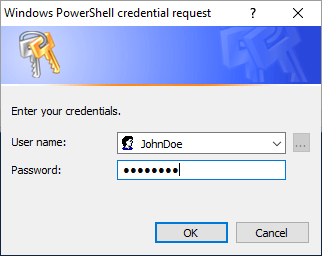
New-PSSession can be used to connect to a remote server.
$pssession = New-PSSession -ComputerName server1.example.com -Credential JohnDoe
When running the command, there should be a pop-up that asks for your password.

It's probably a good idea to print a warning message if the connection failed and then exit.
$pssession = New-PSSession -ComputerName server1.example.com -Credential JohnDoe -ErrorAction SilentlyContinue
if (-not $pssession) {
Write-Warning "Failed to connect to $server with ID $xid - Got the following Exception:"
Write-Warning $Error[0]
exit
}
Or like ths, using try and catch.
try {
$pssession = New-PSSession -ComputerName server1.example.com -Credential JohnDoe -ErrorAction Stop
}
catch {
Write-Warning "Failed to connect to $server with ID $xid - Got the following Exception:"
Write-Warning $Error[0]
exit
}
If you are ok with storing username and password in the PowerShell script, you could do something like this, and then you won't be prompted for your password.
$password = ConvertTo-SecureString "SuperSecretPassword" -AsPlainText -Force
$cred = New-Object System.Management.Automation.PSCredential ("JohnDoe", $password )
$pssession = New-PSSession -ComputerName server1.example.com -Credential $cred
The Get-PSSession command should now return something like this.
Id Name ComputerName ComputerType State ConfigurationName Availability
-- ---- ------------ ------------ ----- ----------------- ------------
1 WinRM1 server1.example.com RemoteMachine Opened Microsoft.PowerShell Available
And you can issue more than one command. Notice in the prior commands that the output of the New-PSSession command is being stored in a variable named $pssession. Printing the $pssession variable
Write-Host $pssession
Should return something like this. This really isn't all that useful.
[PSSession]WinRM1
PSSession contains certain keys, such as InstanceId. Printing the $pssession.InstanceId key
Write-Host Instance ID = $pssession.InstanceId
Should return the Instance ID.
Instance ID = 46d99d57-457f-4ba3-adf5-5922a083992a
This is much more useful, because then Remove-PSSession can be used to end the connection to the target server.
Remove-PSSession -InstanceId $pssession.InstanceId
Did you find this article helpful?
If so, consider buying me a coffee over at 